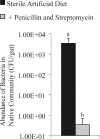Robustness of the bacterial community in the cabbage white butterfly larval midgut
- PMID: 19924467
- PMCID: PMC2836246
- DOI: 10.1007/s00248-009-9595-8
Robustness of the bacterial community in the cabbage white butterfly larval midgut
Abstract
Microbial communities typically vary in composition and structure over space and time. Little is known about the inherent characteristics of communities that govern various drivers of these changes, such as random variation, changes in response to perturbation, or susceptibility to invasion. In this study, we use 16S ribosomal RNA gene sequences to describe variation among bacterial communities in the midguts of cabbage white butterfly (Pieris rapae) larvae and examine the influence of community structure on susceptibility to invasion. We compared communities in larvae experiencing the same conditions at different times (temporal variation) or fed different diets (perturbation). The most highly represented phylum was Proteobacteria, which was present in all midgut communities. The observed species richness ranged from six to 15, and the most abundant members affiliated with the genera Methylobacteria, Asaia, Acinetobacter, Enterobacter, and Pantoea. Individual larvae subjected to the same conditions at the same time harbored communities that were highly similar in structure and membership, whereas the communities observed within larval populations changed with diet and over time. In addition, structural changes due to perturbation coincided with enhanced susceptibility to invasion by Enterobacter sp. NAB3R and Pantoea stewartii CWB600, suggesting that resistance to invasion is in part governed by community structure. These findings along with the observed conservation of membership at the phylum level, variation in structure and membership at lower taxonomic levels, and its relative simplicity make the cabbage white butterfly larval community an attractive model for studying community dynamics and robustness.
Figures





Similar articles
-
Census of the bacterial community of the gypsy moth larval midgut by using culturing and culture-independent methods.Appl Environ Microbiol. 2004 Jan;70(1):293-300. doi: 10.1128/AEM.70.1.293-300.2004. Appl Environ Microbiol. 2004. PMID: 14711655 Free PMC article.
-
Impact on bacterial community in midguts of the Asian corn borer larvae by transgenic Trichoderma strain overexpressing a heterologous chit42 gene with chitin-binding domain.PLoS One. 2013;8(2):e55555. doi: 10.1371/journal.pone.0055555. Epub 2013 Feb 15. PLoS One. 2013. PMID: 23457472 Free PMC article.
-
Bacterial diversity analysis of larvae and adult midgut microflora using culture-dependent and culture-independent methods in lab-reared and field-collected Anopheles stephensi-an Asian malarial vector.BMC Microbiol. 2009 May 19;9:96. doi: 10.1186/1471-2180-9-96. BMC Microbiol. 2009. PMID: 19450290 Free PMC article.
-
Acquisition and structuring of midgut bacterial communities in gypsy moth (Lepidoptera: Erebidae) larvae.Environ Entomol. 2014 Jun;43(3):595-604. doi: 10.1603/EN14031. Epub 2014 Apr 28. Environ Entomol. 2014. PMID: 24780292
-
Culture-dependent and culture-independent characterization of microorganisms associated with Aedes aegypti (Diptera: Culicidae) (L.) and dynamics of bacterial colonization in the midgut.Acta Trop. 2010 Sep;115(3):275-81. doi: 10.1016/j.actatropica.2010.04.011. Epub 2010 Apr 29. Acta Trop. 2010. PMID: 20434424
Cited by
-
Metamorphosis of a butterfly-associated bacterial community.PLoS One. 2014 Jan 23;9(1):e86995. doi: 10.1371/journal.pone.0086995. eCollection 2014. PLoS One. 2014. PMID: 24466308 Free PMC article.
-
Microbial diversity in the midguts of field and lab-reared populations of the European corn borer Ostrinia nubilalis.PLoS One. 2011;6(6):e21751. doi: 10.1371/journal.pone.0021751. Epub 2011 Jun 30. PLoS One. 2011. PMID: 21738787 Free PMC article.
-
The Diversity of Wolbachia and Other Bacterial Symbionts in Spodoptera frugiperda.Insects. 2024 Mar 22;15(4):217. doi: 10.3390/insects15040217. Insects. 2024. PMID: 38667347 Free PMC article.
-
Microbiome analysis of monarch butterflies reveals effects of development and diet.FEMS Microbiol Ecol. 2024 Nov 23;100(12):fiae143. doi: 10.1093/femsec/fiae143. FEMS Microbiol Ecol. 2024. PMID: 39557647 Free PMC article.
-
Lessons from studying insect symbioses.Cell Host Microbe. 2011 Oct 20;10(4):359-67. doi: 10.1016/j.chom.2011.09.001. Cell Host Microbe. 2011. PMID: 22018236 Free PMC article. Review.
References
Publication types
MeSH terms
Substances
Grants and funding
LinkOut - more resources
Full Text Sources
Molecular Biology Databases

